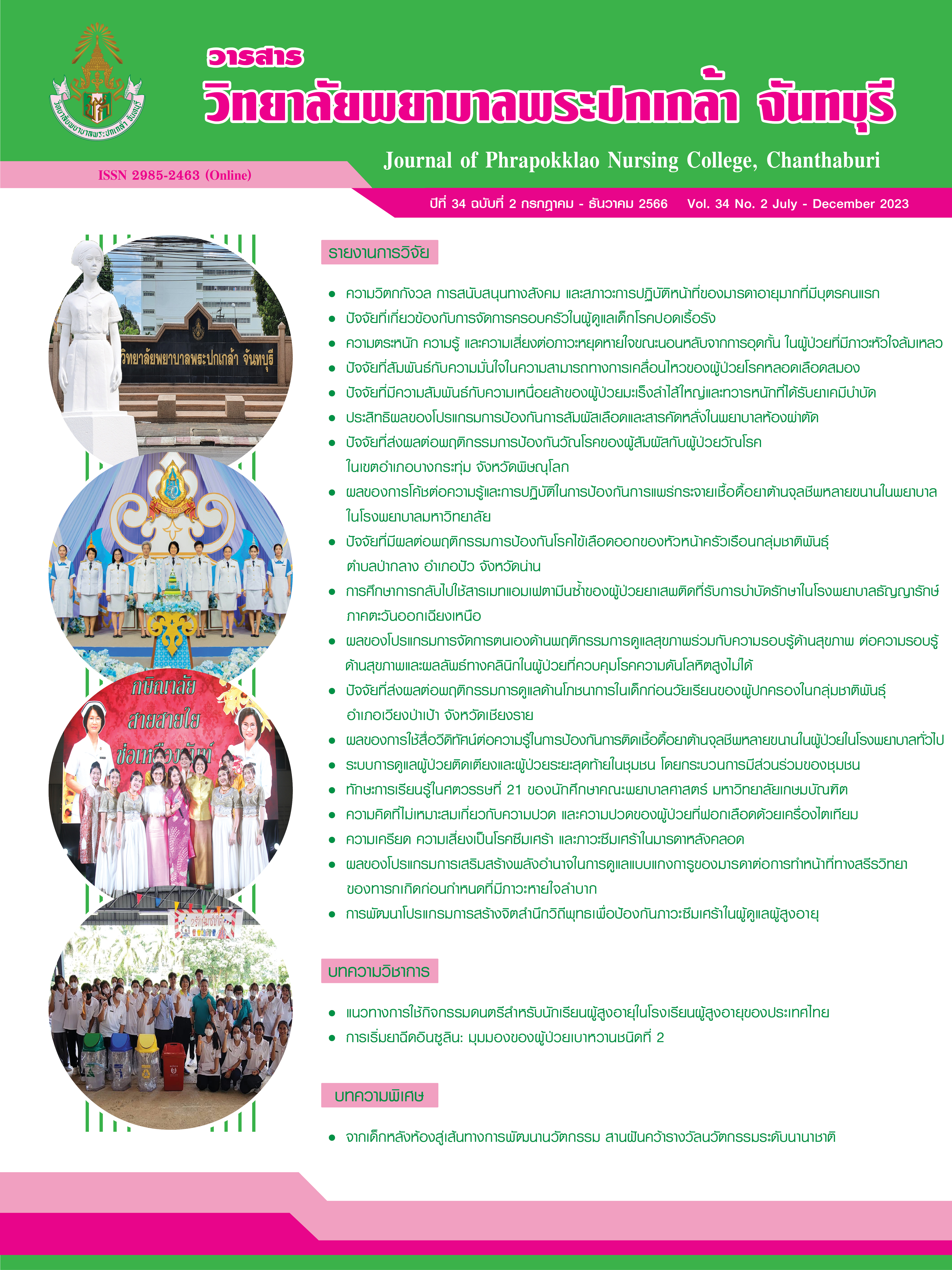Stress, Risk of Depression, and Depression among Postpartum Mothers
Keywords:
Stress, Risk of depression, Depression, Postpartum motherAbstract
This cross-sectional descriptive research aimed to study the prevalence and accordance of stress, risk of depression, and depression among postpartum mothers. The samples consisted of 76 mothers within 48–72 hours postpartum in Phang Khon Hospital, Sakon Nakhon Province. The research instruments were composed of a general data questionnaire, a 5-question stress assessment form (ST-5) with a reliability of .73, a 2-question depression risk assessment form (2Q) with a reliability of .75, and a 9-question depression assessment form (9Q) with a reliability of .82. Data were collected from May to November 2021. Statistics used for data analysis included frequency, percentage, and weighted kappa.
The research results revealed that 1) 11.84% of postpartum mothers had moderate to high level of stress and had risk of depression, and 10.53% of them had mild to moderate level of depression; and 2) according to the assessment, the stress score was not accordant with the risk of depression score and the depression score (weighted kappa = -.063, 95% CI = -.154–.028 and weighted kappa = .131, 95% CI = -.143–.405, respectively) as well as the risk of depression score was not accordant with the depression score (weighted kappa = -.002, 95% CI = -.059–.055).
This research suggests that nurses in postpartum ward should assess stress, risk of depression, and depression among postpartum mothers before discharging by three assessment forms simultaneously. If any abnormal condition is found, the mothers should receive an appropriate care promptly.
References
กรมสุขภาพจิต กระทรวงสาธารณสุข. (2558). แนวทางการใช้เครื่องมือด้านสุขภาพจิตสำหรับบุคลากรสาธารณสุขในโรงพยาบาลชุมชน (คลินิกโรคเรื้อรัง) ฉบับปรับปรุง. นนทบุรี: ผู้แต่ง.
กรมอนามัย กระทรวงสาธารณสุข. (2563). สมุดบันทึกสุขภาพแม่และเด็ก. นนทบุรี: ผู้แต่ง.
ทรรพนันท์ จุลพูล, และชื่นฤทัย ยี่เขียน. (2558). การศึกษาภาวะซึมเศร้าของมารดาหลังคลอด. วารสารวิทยาลัยพยาบาลพระปกเกล้า จันทบุรี, 26(1), 64–74.
ทิพย์วรรณ บุณยาภรณ์, และชุติกาญจน์ แซ่ตั้น. (2560). บทบาทพยาบาล: การจัดการความเครียดในหญิงตั้งครรภ์วัยรุ่น. วารสารเครือข่ายวิทยาลัยพยาบาลและการสาธารณสุขภาคใต้, 4(3), 271–281.
ธรณินทร์ กองสุข, สุวรรณา อรุณพงค์ไพศาล, ศุภชัย จันทร์ทอง, เบญจมาศ พฤกษ์กานนท์, สุพัตรา สุขาวห, และจินตนา ลี้จงเพิ่มพูน. (2561). ความเที่ยงตรงตามเกณฑ์การวินิจฉัยโรคซึมเศร้าของแบบประเมินอาการซึมเศร้า 9 คำถาม ฉบับปรับปรุงภาษากลาง. วารสารสมาคมจิตแพทย์แห่งประเทศไทย, 63(4), 321–334.
นภัสนันท์ สุขเกษม, รัชนี เรืองพรวิสุทธิ์, พรรณพิไล ศรีอาภรณ์, วีรพันธ์ ศิริฤทธิ์, และพรรณา วัชรประภาพงศ์. (2559). ปัจจัยทำนายภาวะซึมเศร้าหลังคลอด. วารสารการพยาบาลและการดูแลสุขภาพ, 34(1), 47–55.
พรรณพิไล ศรีอาภรณ์, นุชนาต สุนทรลิ้มศิริ, กนกพร จันทราทิตย์, จิราวรรณ ดีเหลือ, จิราภรณ์ นันท์ชัย, และพฤกษลดา เขียวคำ. (2558). ปัจจัยที่เกี่ยวข้องกับภาวะซึมเศร้าหลังคลอดของมารดาและบิดาที่มีบุตรคนแรก. พยาบาลสาร, 42(3), 37–50.
วรรณี นวลฉวี, ทวีศักดิ์ กสิผล, และกนกพร นทีธนสมบัติ. (2561). ความชุกของภาวะซึมเศร้าหลังคลอดและปัจจัยทำนายภาวะซึมเศร้าหลังคลอดในมารดาหลังคลอด. วารสาร มฉก.วิชาการ, 21(42), 65–78.
สร้อย อนุสรณ์ธีรกุล, กิ่งแก้ว สิทธิ, อัญชลี อ้วนแก้ว, สุภาพักตร์ หาญกล้า, และภัสพร โมฆะรัตน์. (2565). ความชุกและความสอดคล้องของความเครียด ความเสี่ยงเป็นโรคซึมเศร้า และภาวะซึมเศร้าของหญิงตั้งครรภ์. วารสารพยาบาลศาสตร์และสุขภาพ, 45(3), 37–47.
สุภัสสรา ภูเมฆ, เอกชัย โควาวิสารัช, มาลี เกื้อนพกุล, และวรัญญา แสงพิทักษ์. (2562). ปัจจัยทำนายภาวะซึมเศร้าของมารดาหลังคลอดที่มารับบริการที่โรงพยาบาลราชวิถี. วารสารวิจัยสุขภาพและการพยาบาล, 35(3), 158–170.
สุวรรณา อรุณพงค์ไพศาล, ธรณินทร์ กองสุข, ณรงค์ มณีทอน, เบญจลักษณ์ มณีทอน, กมลเนตร วรรณเสวก, จินตนา ลี้จงเพิ่มพูน, ... สิรีธร บุตรวงศ์. (2550). การพัฒนาและความเที่ยงตรงของแบบคัดกรองโรคซึมเศร้าชนิด 2 คำถาม ในชุมชนไทยอิสาน. วารสารสมาคมจิตแพทย์แห่งประเทศไทย, 52(2), 138–148.
อรวรรณ ศิลปกิจ. (2551). แบบวัดความเครียดฉบับศรีธัญญา. วารสารสุขภาพจิตแห่งประเทศไทย, 16(3), 177–185.
เอกชัย เพ็ชรพรประภาส. (2563). ความชุกและปัจจัยที่เกี่ยวข้องกับภาวะซึมเศร้าหลังคลอดในโรงพยาบาลบางพลี จังหวัดสมุทรปราการ. จิตเวชวิทยาสาร, 36(2), 172–185.
Agrawal, I., Mehendale, A. M., & Malhotra, R. (2022). Risk factors of postpartum depression. Cureus, 14(10), e30898. doi:10.7759/cureus.30898
Bina, R. (2020). Predictors of postpartum depression service use: A theory-informed, integrative systematic review. Women and Birth, 33(1), 24–32. doi:10.1016/j.wombi.2019.01.006
Cochran, W. G. (1977). Sampling techniques (3rd ed.). New York: John Wiley & Sons.
Drake, E., & White, M. S. (2019). Postpartum adaptations and nursing care. In S. S. Murray, E. S. McKinney, K. S. Holub, & R. Jones (Eds.), Foundations of maternal-newborn and women’s health nursing (pp. 458–464). St. Louis, MO: Elsevier.
Giallo, R., Seymour, M., Dunning, M., Cooklin, A., Loutzenhiser, L., & McAuslan, P. (2015). Factors associated with the course of maternal fatigue across the early postpartum period. Journal of Reproductive and Infant Psychology, 33(5), 528–544. doi:10.1080/02646838.2015.1021769
Hassanzadeh, R., Abbas-Alizadeh, F., Meedya, S., Mohammad-Alizadeh-Charandabi, S., & Mirghafourvand, M. (2020). Fear of childbirth, anxiety and depression in three groups of primiparous pregnant women not attending, irregularly attending and regularly attending childbirth preparation classes. BMC Women’s Health, 20(1), 180. doi:10.1186/s12905-020-01048-9
Kiruthiga, V. (2017). Emotive whims distressing pregnant women. International Research Journal of Engineering and Technology, 4(8), 2194–2196. Retrieved from https://www.irjet.net/archives/V4/i8/IRJET-V4I8395.pdf
Marshall, J. E., & Raynor, M. D. (Eds.). (2020). Myles textbook for midwives (17th ed.). Warsaw, Poland: Elsevier.
Shahhosseini, Z., Pourasghar, M., Khalilian, A., & Salehi, F. (2015). A review of the effects of anxiety during pregnancy on children’s health. Materia Socio-Medica, 27(3), 200–202. doi:10.5455/msm.2015.27.200-202
Tahirkheli, N. N., Cherry, A. S., Tackett, A. P., McCaffree, M. A., & Gillaspy, S. R. (2014). Postpartum depression on the neonatal intensive care unit: Current perspectives. International Journal of Women’s Health, 6, 975–987. doi:10.2147/IJWH.S54666
Downloads
Published
How to Cite
Issue
Section
License
Copyright (c) 2023 Journal of Phrapokklao Nursing College, Chanthaburi

This work is licensed under a Creative Commons Attribution-NonCommercial-NoDerivatives 4.0 International License.
เนื้อความ ข้อมูล และรายการอ้างอิงที่ผู้เขียนใช้ในการเขียนบทความเพื่อลงตีพิมพ์ในวารสารวิทยาลัยพยาบาลพระปกเกล้า จันทบุรี ถือเป็นความคิดเห็นและความรับผิดชอบของผู้เขียน คณะผู้จัดทำวารสารไม่จำเป็นต้องเห็นพ้องด้วยหรือร่วมรับผิดชอบ
บทความที่ได้รับการลงตีพิมพ์ในวารสารวิทยาลัยพยาบาลพระปกเกล้า จันทบุรี ถือเป็นลิขสิทธิ์ของวารสารวิทยาลัยพยาบาลพระปกเกล้า จันทบุรี หากหน่วยงานหรือบุคคลใดต้องการนำส่วนหนึ่งหรือทั้งหมดของบทความไปเผยแพร่ต่อเพื่อวัตถุประสงค์ใด ๆ จะต้องได้รับอนุญาตจากบรรณาธิการวารสารก่อน



